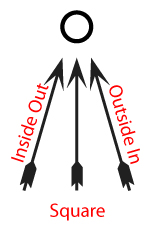Making unexpected shots will take your golf game to the next level. To make these shots you need to know what you, and your clubs, are capable of. By thinking outside of the box you can easily get out of many tricky situations around the golf course and save par.
In the video above Golf Pro Bill McKinney shows you how a hybrid golf club can get you up and over a tree that’s right in front of you, and still have enough carry to reach a green that is 170 yards away.
Normally in a situation like this, most golfers would choose to get over the tree with a 9 iron, sacrificing distance and their chance to make it to the green. This is a safe shot, but there is another option. A club like a #5 Hybrid has enough loft to get over the tree and will give you the extra carry you need to make it to the green.
The secret here is knowing what your clubs are capable of, but also spending time on the range experimenting with different shots. For this shot you simply need to make a shorter quicker swing. By tweaking your normal swing just a bit you can turn your #5 hybrid into a 9 iron on steroids. You’ll be able to clear the tree without sacrificing your score on the hole.
The best part is, if you practice these kinds of specialty golf shots, they won’t even seem risky when you use them on the course, it’ll be business as usual. And did I mention hitting these shots is a lot of fun.
So do yourself a favor, next time you hit the range try some trick shots, it’ll help your score and you’ll have a great time. Click here for more great golf tips from Bill McKinney.
For better golf,
Doc O’Leary
Head Golf Nut, OHP










 Learning how to shape your golf shots (hit a draw or fade when you want to) is crucial if you want to take your golf game to the next level.
Learning how to shape your golf shots (hit a draw or fade when you want to) is crucial if you want to take your golf game to the next level.  The key is understanding the two key variables that affect where the golf ball goes. The first variable is the way the club approaches the ball (inside out, outside in, or square). The diagram to the right shows these angles in case you are having trouble visualizing this (note: the diagram on the right is for a right handed golfer, it would be opposite for lefties).
The key is understanding the two key variables that affect where the golf ball goes. The first variable is the way the club approaches the ball (inside out, outside in, or square). The diagram to the right shows these angles in case you are having trouble visualizing this (note: the diagram on the right is for a right handed golfer, it would be opposite for lefties).